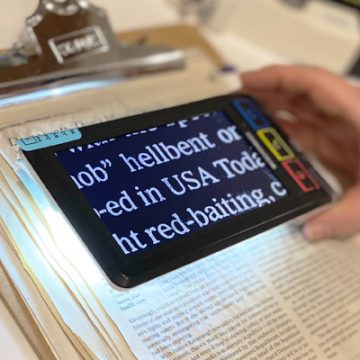Blog
Magnifying Devices Help Those With Vision Loss

By Angel Pacheco
Originally posted on Able News
Experts have been assessing and training individuals in assistive technology for decades. Great strides have been made in all areas of accessibility, but there is still a need for that one product that will benefit all people who have low vision.
Some magnification options have been around longer than many people have been on this planet. This includes pocket magnifiers, eye loupes and handheld magnifiers.
In the last few decades, low vision magnifier readers, closed-circuit TV/CCTV, magnification cameras that plug into televisions and computer screens and wearable video magnification devices, to name a few, have popped up by the dozens. Higher end CCTVs now include optical character recognition and will read the text the camera is pointed to back to a person.
Smart phones have come a long way as well. For example, people with low vision can take a picture of what is in front of them and enlarge it to identify items. The abundant number of apps and other features available on smart phones can assist a low vision user to become independent in various ways.
One of the questions people often ask is, “Will a larger screen benefit me?” The response is that there are many factors to consider prior to buying a larger screen.
Here are three questions to ask, “How low is the low vision? Depending on the visual diagnosis, is the user able to see full characters or images? Will glare from the screen bother the user?”
Here are some issues one may run into. Placing a picture on a larger screen, does not guarantee that one will see the image better. Also, if someone plans to watch a video on a larger monitor screen, they may not be able to keep up with it as there will be a larger territory to cover. Larger is not always better.
There are numerous vendors of magnification devices to select from today. A good motto is to always try before buying. No one wants to make a costly purchase and end up with a device that may not have an option they require or a device that will not work for them at all.
The hope for the future of assistive technology is that software will be designed in a similar way to the human eye so that any camera can identify an entire environment and not just random items. A feature that should be included is the ability to decrease the feedback depending on the user’s needs/ wants, rather than being fed unnecessary details.
So, if there are programmers out there that are ready for the challenge, this is one to consider. There is hope for a future where everyone can see the world.
Angelo Pacheco is program administrator at Vision Rehabilitation Services for Lighthouse Guild.
Join our Mission
Lighthouse Guild is dedicated to providing exceptional services that inspire people who are visually impaired to attain their goals.
